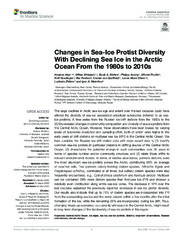Changes in Sea-Ice Protist Diversity With Declining Sea Ice in the Arctic Ocean From the 1980s to 2010s
Permanent lenke
https://hdl.handle.net/10037/19946Dato
2020-05-06Type
Journal articleTidsskriftartikkel
Peer reviewed
Forfatter
Hop, Haakon; Vihtakari, Mikko; Bluhm, Bodil; Assmy, Philipp; Poulin, Michel; Gradinger, Rolf; Peeken, Ilka; von Quillfeldt, Cecilie; Olsen, Lasse Mork; Zhitina, Ludmila; Melnikov, Igor A.Sammendrag
The large declines in Arctic sea-ice age and extent over the last decades could have altered the diversity of sea-ice associated unicellular eukaryotes (referred to as sea-ice protists). A time series from the Russian ice-drift stations from the 1980s to the 2010s revealed changes in community composition and diversity of sea-ice protists from the Central Arctic Ocean. However, these observations have been biased by varying levels of taxonomic resolution and sampling effort, both of which were higher in the early years at drift stations on multiyear sea ice (MYI) in the Central Arctic Ocean. We here combine the Russian ice-drift station data with more recent data to (1) identify common sea-ice protists (in particular diatoms) in drifting sea ice of the Central Arctic Ocean; (2) characterize the potential change in such communities over 35 years in terms of species number and/or community structure; and (3) relate those shifts to relevant environmental factors. In terms of relative abundance, pennate diatoms were the most abundant sea-ice protists across the Arctic, contributing 60% on average of counted cells. Two pennate colony-forming diatom species, Nitzschia frigida and Fragilariopsis cylindrus, dominated at all times, but solitary diatom species were also frequently encountered, e.g., Cylindrotheca closterium and Navicula directa. Multiyear sea ice contained 39% more diatom species than first-year ice (FYI) and showed a relatively even distribution along entire sea-ice cores. The decrease in MYI over the last decades explained the previously reported decreases in sea-ice protist diversity. Our results also indicate that up to 75% of diatom species are incorporated into FYI from the surrounding sea ice and the water column within a few months after the initial formation of the ice, while the remaining 25% are incorporated during ice drift. Thus, changing freeze-up scenarios, as currently witnessed in the Central Arctic, might result in long-term changes of the biodiversity of sea-ice protists in this region.
Forlag
Frontiers MediaSitering
Hop, Vihtakari, Bluhm, Assmy, Poulin, Gradinger, Peeken, von Quillfeldt, Olsen, Zhitina, Melnikov. Changes in Sea-Ice Protist Diversity With Declining Sea Ice in the Arctic Ocean From the 1980s to 2010s. Frontiers in Marine Science. 2020;7Metadata
Vis full innførselSamlinger
Copyright 2020 The Author(s)


 English
English norsk
norsk